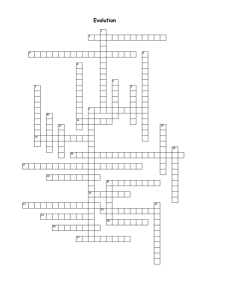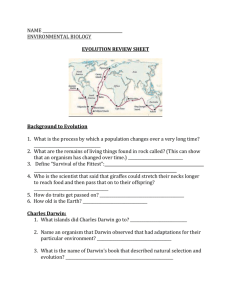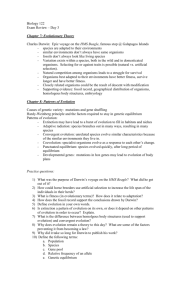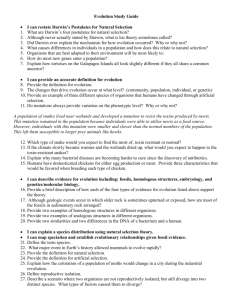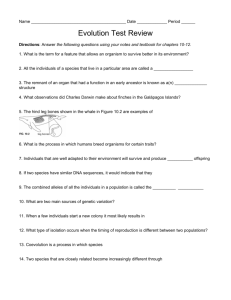Evolution Notes
advertisement
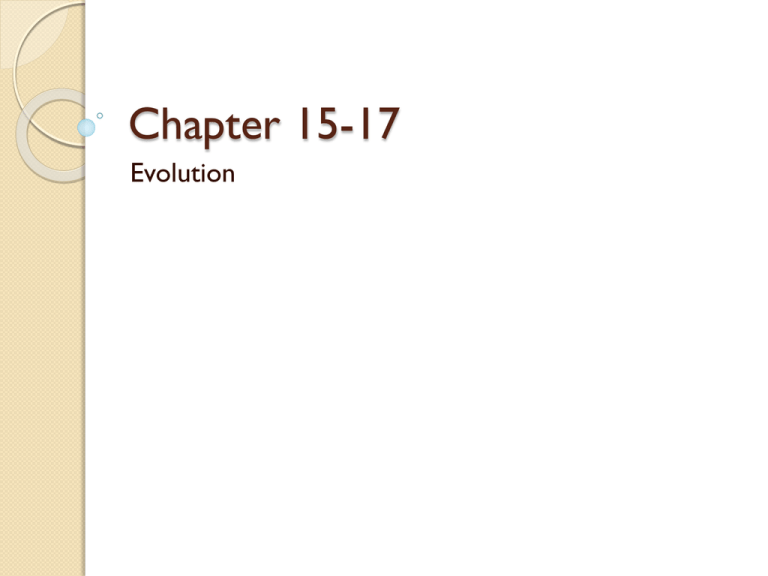
Chapter 15-17 Evolution What is evolution? Evolution is change over time Theory of evolution – process by which modern organisms have descended from ancient organisms Remember that a scientific theory is a wellsupported testable explanation of phenomena that have occurred in the natural world Where did the idea of evolution come from? Charles Darwin made numerous observations and collected evidence that led him to propose his hypothesis about the way life changes over time ◦ Collected plant/animal specimens where ship anchored ◦ Learned that an enormous number of species exist ◦ Noticed how well suited organisms are to their environment Galapagos Tortoises Lamarck and Evolution In 1809 Lamarck proposed that by selective use or disuse of organs, organisms acquire or lose certain traits ◦ These traits can then be passed to offspring ◦ This could lead to a change in the species Lamarck and Evolution Darwin and Evolution “On the Origin of Species” was published in 1859 by Charles Darwin ◦ Darwin proposed natural selection as a mechanism for evolution ◦ Competition for resources leads to survival of the fittest ◦ Successful adaptation means the organism has and advantage to survival and reproduction ◦ Adaptation – any inherited characteristic that increases an organism’s chance of survival ◦ Over time natural selection results in the inherited characteristics of a population Darwin and Evolution Darwin proposed that each species has descended, with changes, from other species over time (descent with modification) The principle of common descent states that all species (living and extinct) were derived from common ancestors (single “tree of life”) Darwin hypothesized that living things have been evolving for millions of years ◦ Evidence found in fossil record, geographical distribution of species, homologous structures of organisms, similarities in early development Darwin and Evolution Types of Evolution Micro-evolution – change in a population’s gene frequencies Macro-evolution – when a new species emerges Species – group of organisms that can reproduce with fertile offspring in nature Variation in the population provides the material for natural selection. Sexual reproduction (the shuffling of alleles and, thus, uniqueness) provides for this variation Evidence for Evolution The fossil record - Strata of fossilized remains of organisms extinct for many years. The oldest layers have the oldest fossils beginning with bacteria. Biogeography – the presence of organisms in areas of the world correlates with the movement of land masses over time ◦ Australia has a unique abundance of marsupials found no where else in the world Comparative anatomy – Organisms share many characteristics called homologous structures ◦ Vestigial structures are parts reduced in size or no longer used by a more recent organism, ex. hip bones of whales Geographic Distribution of Species Homologous Body Structures Evidence for Evolution Comparative embryology – Similarities exist between many animals as they are developing DNA or molecular similarities – All organisms share the same genetic code, ATCG’s. Most of the codons match the same amino acids. Population studies – We can see bacterial populations change over time ◦ Bacteria exposed to antibiotics will die except for the resistant few ◦ The resistant ones live and reproduce, creating a population of bacteria resistant to the antibiotic. Similarities in Embryology Evolution and Isolation Geographic isolation – when populations are split by geographic barriers, they sometimes change so that when brought back together, they can’t have offspring together Reproductive isolation – when organisms in a population do not interbreed for some reason and become distinctly different groups. ◦ In plants this can occur as a mistake in meiosis, and the new plant will not have the correct chromosome number for successful zygote formation. ex. salamander ring species Genetics and Evolution Gene pool- all genes, including the different alleles, in a population Relative frequency- number of times that an allele occurs in a gene pool Genetically, evolution is any change in the relative frequency of alleles in a population ◦ Mouse fur frequencies begin B is 40%, b is 60% (B=black, b=brown) ◦ If it changes to B=30%, then the population is evolving Sources of Genetic Variation Mutations are a change to the sequence of DNA, which may result in a phenotype change ◦ Can be caused by mistake in replication or radiation/chemicals During gamete productions gene shuffling occurs (independent assortment and crossing over) ◦ Can produce a huge variety in phenotypes ◦ Does not change relative frequency ◦ Can result in unique phenotypes that could be an advantage Genetics and Evolution Evolutionary fitness is an organism’s success at passing genes to the next generation However, natural selection never acts on genes only on the organism as a whole In addition, evolution is about the frequency of alleles for an entire population, not and individual organism Genetics and Evolution Natural selection on single-gene traits can lead to changes in allele frequencies and thus to evolution The red lizards are more visible; black lizards warm faster, which allows them to be more active sooner Genetics and Evolution Natural selection can affect polygenic traits (trait controlled by 2 or more genes) in 3 ways: ◦ Directional selection occurs when individuals on one end of a phenotype curve have higher fitness Low mortality, high fitness High mortality, low fitness Genetics and Evolution ◦ Stabilizing selection occurs when higher fitness at the center of the curve than the ends Low mortality, ◦ Weight of Selection high fitness against both High mortality, extremes keep human infants low fitness Brightness of Feather Color curve narrow and in same place. Genetics and Evolution ◦ Disruptive selection occurs when the ends of the phenotype curve have higher fitness than the middle Can cause it to split into 2 Medium sized seeds become less common Genetics and Evolution Genetic equilibrium occurs when allele frequencies remain constant; 5 requirements ◦ Random mating (not true in organisms like elk) ◦ Large population ◦ No movement into or out of the population ◦ No mutations ◦ No natural selection History of Life Biogenesis – Life comes only from life. Abiogenesis – spontaneous generation, life can come from the nonliving Louis Pasteur – disproved spontaneous generation by sterilizing broth solutions. Stanley Miller and Harold Urey (1950’s) simulated early earth in the lab. By making amino acids in the lab. http://www.ucsd.tv/miller-urey/ Pasteur’s Experiment Miller and Urey Experiment
